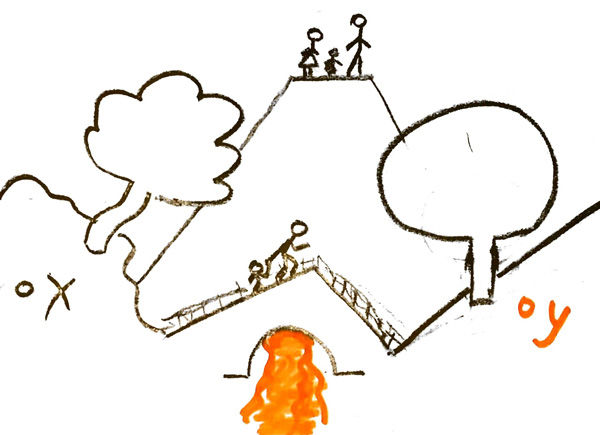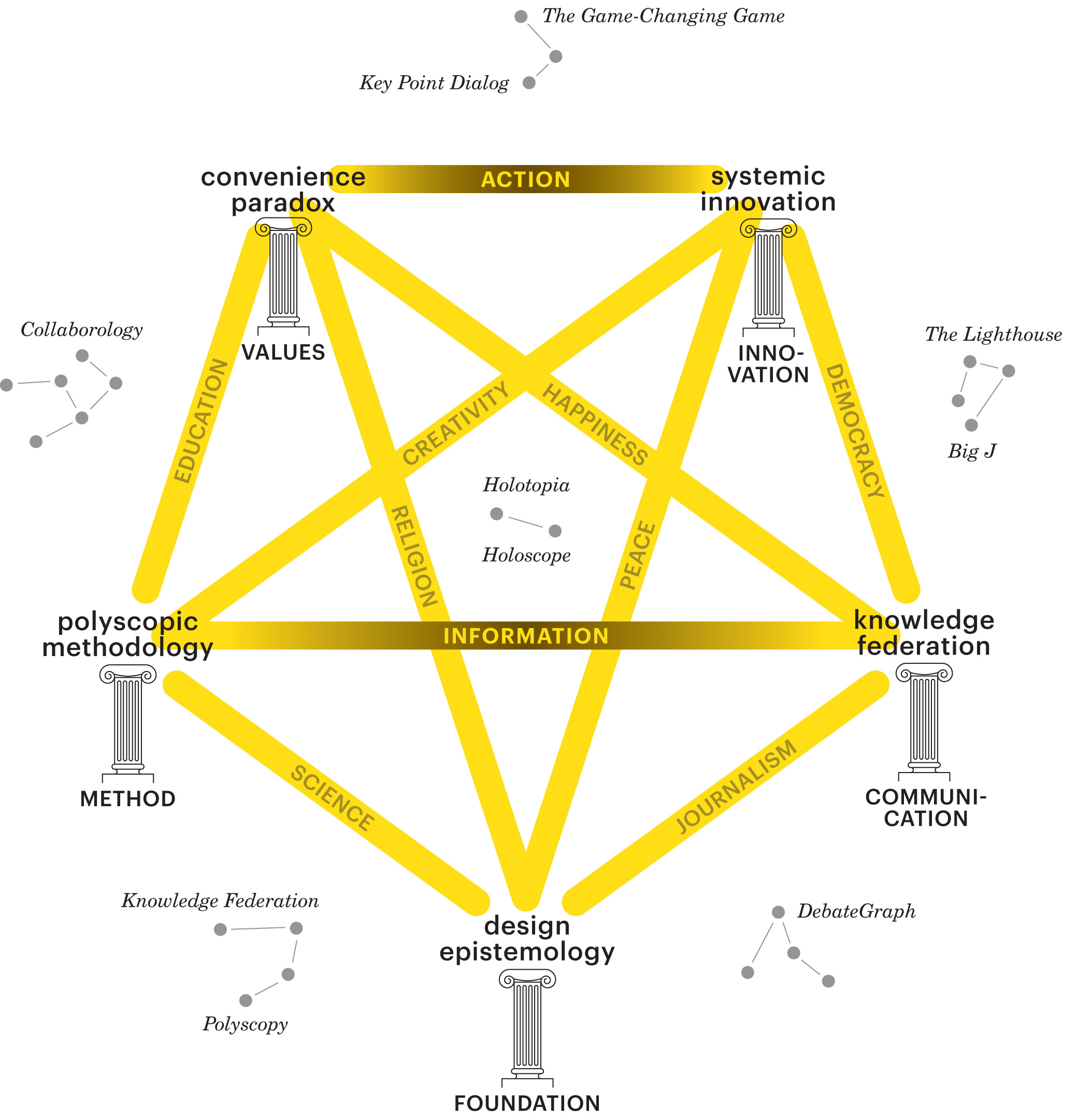Difference between revisions of "N-ideograms"
m |
m |
||
| Line 44: | Line 44: | ||
<p>We may begin to <em><b>federate knowledge</b></em> by looking at the <em><b>realm of experience</b></em> or the practical world from the mountain top; and identify a theme—<em>any</em> theme—that demands attention; and then take this theme over the bridge to the <em><b>realm of ideas</b></em>, along with other experiences or data that provide it a suitable context, and theorize it and comprehend it; and then take the result back over the bridge and <em>act</em> in an informed way.</p> | <p>We may begin to <em><b>federate knowledge</b></em> by looking at the <em><b>realm of experience</b></em> or the practical world from the mountain top; and identify a theme—<em>any</em> theme—that demands attention; and then take this theme over the bridge to the <em><b>realm of ideas</b></em>, along with other experiences or data that provide it a suitable context, and theorize it and comprehend it; and then take the result back over the bridge and <em>act</em> in an informed way.</p> | ||
| − | <p>The bridge is makes this possible; it | + | <p>The bridge is what makes this possible; it stands for the (general-purpose) [[methodology|<em>methodology</em>]], which—unlike the methods provided by the sciences—can be applied freely to <em>any</em> theme of choice.</p> |
| − | <p>The mountain stands for abstraction; it empowers us to <em>structure</em> <em><b>knowledge</b></em>; to rise above the information jungle and see where the roads lead | + | <p>The mountain stands for abstraction; it empowers us to <em>structure</em> <em><b>knowledge</b></em>; to rise above the information jungle and see where the roads lead, and which is the one to be followed.</p> |
| − | <p>Science gave us "Newton's laws" and other "laws of nature"; and empowered us to comprehend the natural world by resorting to a handful of simple | + | <p>Science gave us "Newton's laws" and other "laws of nature"; and empowered us to comprehend the natural world by resorting to a handful of simple insights and principles. The aim of <em><b>knowledge federation</b></em>, and of <em><b>transdisciplinarity</b></em>, is to empower the human reason, and us <em>collectively</em>—to comprehend and handle all themes that matter in a manner we can rely on; which empowers us to <em>handle</em> them correctly.</p> |
<p>"The Matrix is the world that has been pulled over your eyes to blind you from the truth", Morpheus told Neo; to introduce him to the dystopian vision that <em>The Matrix</em> epitomized. As long as we have no other frame of reference than the world itself—we can only <em>adapt</em> to the world as it is, however absurd or dysfunctional or dangerous it may have become.</p> | <p>"The Matrix is the world that has been pulled over your eyes to blind you from the truth", Morpheus told Neo; to introduce him to the dystopian vision that <em>The Matrix</em> epitomized. As long as we have no other frame of reference than the world itself—we can only <em>adapt</em> to the world as it is, however absurd or dysfunctional or dangerous it may have become.</p> | ||
| − | <h3> | + | <h3><em>Transdisciplinarity</em> provides an <em>independent</em> reference system.</h3> |
| + | <p>Represented by <em>the realm of ideas</em>; which makes us capable of <em>improving</em> the world.</p> | ||
<h2>Holotopia ideogram</h2> | <h2>Holotopia ideogram</h2> | ||
</div> | </div> | ||
Revision as of 16:19, 24 October 2023
Contents
Federation through Ideograms
According to dictionary definition, ideograms are pictures that represent ideas; but in knowledge federation, they are a lot more than that.
An ideogram compresses "one thousand words" into an image; and makes the gist of it all recognizable at a glance.
The ideograms that are shown here are only a placeholder—for a variety of techniques that can and will be developed; by combining the expressiveness of the arts with the capabilities of new and old media technologies.
Modernity ideogram
The error is that information is not conceived of and handled in accordance to what it is—a human-made thing for human purposes; which must fulfill its functions within other human-made things—notably in the systems in which we live and work or our various institutions, including the global human society; so that they can function and be sustainable or whole.
The knowledge federation transdiscipline is a complete prototype of the socio-technical 'lightbulb'.
In One Hundred Pages for the Future, in 1981, based on a decade of The Club of Rome’s research into the future prospects of mankind, Aurelio Peccei—this global think tank’s leader and co-founder—concluded: “It is absolutely necessary to find a way to change course.”
Changing the 'headlights' by instituting transdisciplinarity is the natural way to "change course".
In his 1969 MIT report and call to action—to institute transdisciplinarity—Erich Jantsch quoted Norbert Wiener, the iconic progenitor of cybernetics:
“There is only one quality more important than ‘know-how’…… This is ‘know-what’ by which we determine not only how to accomplish our purposes, but what our purposes are to be.”
Academic disciplines cannot provide us know-what; and the media informing, such as it is, won't do it either. A system that provides us knowledge about any of the core themes of our lives and times must combine disciplinary and other evidence; it must transcend academic and cultural fragmentation; it must communicate to the public with the authority of science—in ways that are well beyond the modalities of outreach that the sciences have been able to produce.
Knowledge Federation ideogram
In Autobiographical Notes, Albert Einstein shared his "epistemological credo":
“I see on the one side the totality of sense experiences and, on the other, the totality of the concepts and propositions that are laid down in books. […] The system of concepts is a creation of man, together with the rules of syntax, which constitute the structure of the conceptual system. […] All concepts, even those closest to experience, are from the point of view of logic freely chosen posits, just as is the concept of causality, which was the point of departure for [scientific] inquiry in the first place.”
The Knowledge Federation ideogram comprises the realm of experience or "the real world" on its left, and the realm of ideas or "the concepts and propositions that are laid down in books"on its right; and there's also a bridge that joins those two sides, and a mountain with some stickmen in its background.
We may begin to federate knowledge by looking at the realm of experience or the practical world from the mountain top; and identify a theme—any theme—that demands attention; and then take this theme over the bridge to the realm of ideas, along with other experiences or data that provide it a suitable context, and theorize it and comprehend it; and then take the result back over the bridge and act in an informed way.
The bridge is what makes this possible; it stands for the (general-purpose) methodology, which—unlike the methods provided by the sciences—can be applied freely to any theme of choice.
The mountain stands for abstraction; it empowers us to structure knowledge; to rise above the information jungle and see where the roads lead, and which is the one to be followed.
Science gave us "Newton's laws" and other "laws of nature"; and empowered us to comprehend the natural world by resorting to a handful of simple insights and principles. The aim of knowledge federation, and of transdisciplinarity, is to empower the human reason, and us collectively—to comprehend and handle all themes that matter in a manner we can rely on; which empowers us to handle them correctly.
"The Matrix is the world that has been pulled over your eyes to blind you from the truth", Morpheus told Neo; to introduce him to the dystopian vision that The Matrix epitomized. As long as we have no other frame of reference than the world itself—we can only adapt to the world as it is, however absurd or dysfunctional or dangerous it may have become.
Transdisciplinarity provides an independent reference system.
Represented by the realm of ideas; which makes us capable of improving the world.
Holotopia ideogram
The Holotopia ideogram shows that when we judiciously choose a handful of pivotal themes or categories ("pivotal" because they determine our society's evolutionary direction) and apply to them knowledge federation—we'll comprehend them and handle them completely differently than we do. And that when we elevate ourselves above "the world" by thinking in terms of basic insights and principles—we'll have a way to comprehend all other themes in completely different ways.
We'll then be able to even reach out to the stars—by creating prototypes; and organizing them into 'constellations'; and not only see a better future—but be able to create it too!



